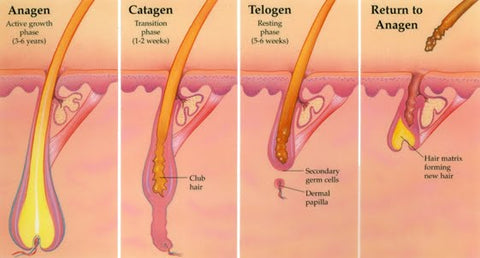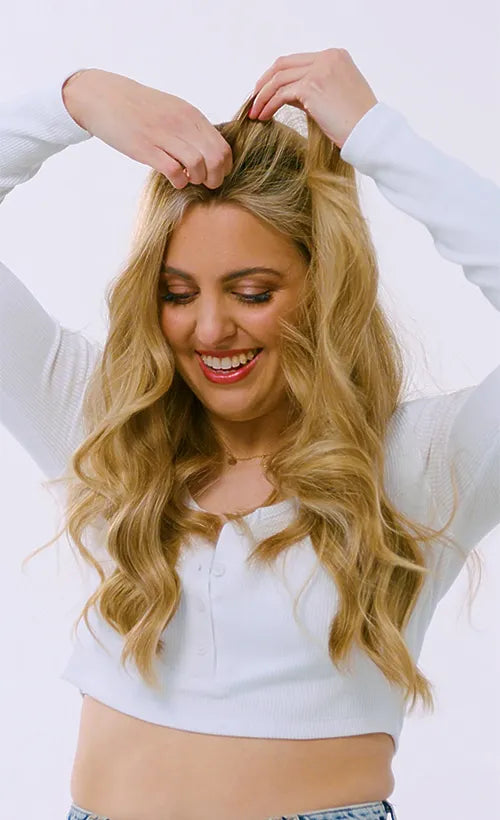Today, we're diving headfirst into the world of Androgenic Alopecia, a topic that might hit close to home for many of us. I'm here to break it all down for you because understanding your options and embracing your beautiful self is what it's all about.
What is Androgenic Alopecia?
Androgenic Alopecia, often referred to as female pattern baldness, is a hair loss condition that can impact women of various ages, and it's more prevalent than you might think. While many people associate hair loss with aging, the truth is, Androgenic Alopecia can rear its head as early as your twenties or thirties, catching you off guard during what are supposed to be some of the best years of your life. But let me assure you, no matter where you find yourself on this journey, you're never alone in facing it. Up to 50% of women will experience hair loss at some point in their life.
If you're feeling alone in your journey, come join our hair loss community.

Who Can Get Androgenic Alopecia?
This condition isn't about a specific age or timeframe; it's about genetics and hormonal changes. Your genes play a significant role in whether you're predisposed to Androgenic Alopecia, and it can affect women from all walks of life, from students to mothers, career women to retirees. It doesn't discriminate based on age or lifestyle.
So, if you're in your twenties and starting to notice changes in your hair, you're not alone. If you're in your thirties, forties, or beyond, and Androgenic Alopecia is becoming more apparent, you're still not alone. This condition doesn't adhere to a set schedule; it's unique to each individual.
Androgenic Alopecia often has a familial connection. It tends to run in families, so if your mother, grandmother, or even aunts experienced this condition, you might be genetically predisposed to it as well. It's like a hereditary hair story that gets passed down through generations.
But here's the silver lining amidst all of this: knowing your family history and recognizing the signs early can be a powerful tool in managing Androgenic Alopecia. You can be proactive and seek out solutions and support to address the issue before it becomes more advanced.

Is Androgenic Alopecia permanent?
In most cases, it's true that once this condition takes hold and those precious hair follicles begin to shrink and miniaturize, they typically don't bounce back on their own. But before you start to worry, let's delve into this a bit deeper and explore what "permanent" really means in the context of Androgenic Alopecia.
When we say that Androgenic Alopecia is typically permanent, we're referring to the fact that the hair loss is an ongoing process. The hair follicles affected by this condition gradually produce finer and shorter strands of hair until, in some cases, they cease to produce hair altogether. This means that without intervention or treatment, the thinning and hair loss can continue over time.
However, it's crucial to emphasize that "permanent" doesn't equate to "hopeless." There are numerous strategies and solutions available to help manage Androgenic Alopecia and regain your confidence. These solutions range from medical treatments and lifestyle changes to the transformative power of wigs and hair toppers.
The Science of Androgenic Alopecia
Androgenic Alopecia is an intricate process that unfolds within your hair follicles, and it's largely orchestrated by a group of hormones called androgens. These hormones are present in both men and women, but it's their specific actions and interactions that play a crucial role in the development of this condition.
Now, imagine your hair follicles as tiny factories that produce your lovely locks. Each hair follicle goes through a natural growth cycle, with phases that include growth (anagen), rest (telogen), and shedding (catagen). In a perfect world, these phases work in harmony to keep your hair thick and healthy. But when Androgenic Alopecia enters the scene, it disrupts this delicate balance.
The key villain in this hair tale is dihydrotestosterone, or DHT for short, which is derived from the hormone testosterone. DHT has a particular affinity for hair follicles on the scalp. When it attaches itself to these follicles, it triggers a series of events that lead to hair thinning and loss.

Here's how it happens:
-
Miniaturization of Hair Follicles: DHT binds to receptors on hair follicles, particularly those on the front, top, and crown of the head. Once bound, it signals the hair follicles to shrink or miniaturize. This miniaturization process results in the production of finer, shorter hairs.
-
Shortened Anagen Phase: DHT also shortens the growth phase (anagen) of the hair follicles. As a result, affected hairs spend less time growing and more time resting, ultimately leading to shorter, thinner strands.
-
Reduced Blood Flow: DHT interferes with the blood supply to the hair follicles, reducing the nutrients and oxygen they receive. This compromised nourishment further contributes to hair thinning.
-
Inflammation: Chronic inflammation can also play a role in Androgenic Alopecia. Inflammation can lead to damage and scarring of hair follicles, making it even more challenging for hair to grow.
-
Gradual Hair Loss: Over time, the effects of DHT accumulation and hormonal changes can lead to progressive hair loss. This is why you may notice a receding hairline, thinning at the crown, or widening of the part as the condition advances.
Can You Prevent Androgenic Alopecia?
While you can't completely prevent this condition, adopting a few healthy habits can make a substantial difference in maintaining the health and vitality of your hair.
-
Maintain a Healthy Lifestyle: Leading a healthy lifestyle is like giving your hair a fighting chance against Androgenic Alopecia. Regular exercise improves blood circulation throughout your body, including your scalp, which can support hair follicle health. Staying active also helps reduce stress, which is a significant contributor to hair loss.
-
A Balanced Diet: Nutrient-rich foods are essential for hair health. Incorporate a balanced diet that includes plenty of vitamins and minerals, such as biotin, zinc, and iron, which are known to promote hair growth. Foods like leafy greens, lean proteins, nuts, and fruits can provide the nutrients your hair needs to thrive.
-
Stress Management: Stress can take a toll on your overall health, including the health of your hair. High stress levels can trigger hair shedding and exacerbate Androgenic Alopecia. Practice stress-reduction techniques like mindfulness, meditation, yoga, or simply setting aside time for activities you enjoy. Remember, a calm mind contributes to a healthy body, and your hair will thank you for it.
-
Gentle Hair Care: Be kind to your hair. Avoid excessive heat styling, tight hairstyles, and harsh chemical treatments that can damage your hair and weaken the follicles. Use a gentle shampoo and conditioner suitable for your hair type to keep your locks in top condition.
-
Scalp Care: A healthy scalp is essential for healthy hair. Regularly cleanse your scalp to remove excess oil and debris, which can clog hair follicles and impede growth. Massaging your scalp can also improve blood circulation and promote hair growth.
-
Consult a Professional: If you notice signs of Androgenic Alopecia, it's essential to seek advice from a healthcare professional or dermatologist. They can provide a proper diagnosis and recommend appropriate treatments or interventions tailored to your specific needs.
What Are the Treatments for Androgenic Alopecia?
It's important to note that the effectiveness of these treatments can vary from person to person, so working closely with a healthcare professional is essential to determine the most suitable approach for your unique needs.
-
Topical Medications (Minoxidil): Minoxidil, commonly known as Rogaine, is an FDA-approved topical medication for the treatment of Androgenic Alopecia. It's available over the counter and comes in both liquid and foam formulations. Minoxidil works by stimulating hair follicles to promote hair growth and is typically applied directly to the scalp twice a day. It's essential to use it consistently for several months to see potential results.
-
Oral Medications (Finasteride): Finasteride, often sold as Propecia, is an FDA-approved oral medication for Androgenic Alopecia. It works by inhibiting the conversion of testosterone into dihydrotestosterone (DHT), the hormone responsible for shrinking hair follicles. While it can be effective in slowing down hair loss and promoting regrowth, it's generally prescribed for men. Women of childbearing age should use it with caution, as it may cause birth defects.
-
Platelet-Rich Plasma (PRP) Injections: PRP therapy involves drawing a small amount of your blood, processing it to concentrate the platelets, and then injecting the PRP into your scalp. Platelets contain growth factors that can stimulate hair follicles and promote hair growth. PRP therapy is a minimally invasive and natural treatment option. While it may not work for everyone, some individuals have seen positive results with multiple sessions over time.
-
Low-Level Laser Therapy (LLLT): Low-level laser therapy is a non-invasive treatment option that uses red or near-infrared light to stimulate hair follicles. It's available in various forms, including laser combs, helmets, and caps. LLLT is believed to increase blood flow to the scalp and promote hair growth. It's a convenient at-home option, but results can be gradual and may require ongoing use.
-
Prescription Medications: In some cases, healthcare professionals may prescribe off-label medications such as spironolactone or birth control pills to address hormonal imbalances contributing to Androgenic Alopecia. These medications are typically used when other treatments haven't yielded satisfactory results.
-
Hair Growth Shampoos and Topical Solutions: Over-the-counter hair growth shampoos and topical solutions often contain ingredients like ketoconazole, caffeine, and biotin, which may help improve the condition of existing hair and create a healthier scalp environment. While they may not be standalone treatments, they can complement other therapies.
-
Hair Transplant Surgery: For individuals with advanced Androgenic Alopecia who haven't responded well to other treatments, hair transplant surgery may be an option. This procedure involves relocating healthy hair follicles from one area of the scalp (usually the back or sides) to the areas affected by hair loss. It can provide a more permanent solution for some individuals.
Remember, the choice of treatment should be based on a thorough evaluation by a healthcare professional or dermatologist. What works for one person may not work for another, and the most effective approach often involves a combination of treatments tailored to your specific needs and goals.
Wigs and Hair Toppers: The Ultimate Solution for Androgenic Alopecia
Let's delve into the world of wigs and hair toppers, the ultimate solutions for those dealing with Androgenic Alopecia. These incredible hairpieces are not just accessories; they're your secret weapon to reclaiming your confidence every single day.

Versatile and Comfortable: Wigs and hair toppers are versatile by nature, which means they adapt to your needs, whether you're in the early stages of Androgenic Alopecia or have more advanced hair loss. They're designed with your comfort in mind, featuring lightweight and breathable materials that ensure you can wear them for extended periods without discomfort.
A Natural-Looking Solution: One of the most remarkable aspects of wigs and toppers is their ability to provide a seamless and natural-looking solution. When crafted with attention to detail, they blend effortlessly with your existing hair. The result? No one will suspect that you're wearing a hairpiece. It's your little secret, allowing you to step out into the world with confidence.
Easy to Put On and Style: The morning routine can be a hectic rush, and the last thing you need is a complicated hairstyling session. Wigs and toppers have got your back in this department. They're incredibly easy to put on, saving you precious time and effort. Whether you prefer a quick and casual look or something more polished, these hairpieces can be styled to suit your preferences.
A Boost of Confidence: Dealing with Androgenic Alopecia can be emotionally challenging, but wigs and toppers offer a powerful solution to boost your confidence. They don't just cover hair loss; they empower you to embrace your unique beauty. With your chosen hairpiece in place, you'll feel like your best, most authentic self, ready to take on the world.
A Personalized Experience: Finding the right hairpiece is like discovering a perfect match. Each person's experience with Androgenic Alopecia is unique, and wigs and toppers cater to this individuality. They come in a variety of styles, lengths, colors, and textures, ensuring that you can select the one that aligns with your personal style and preferences. It's like having a custom-made hair solution just for you.
In conclusion, wigs and hair toppers aren't just fashion accessories; they're transformative tools that enable you to live life on your terms. They offer a natural, comfortable, and confidence-boosting way to navigate the challenges of Androgenic Alopecia. Whether you're in the early stages of hair loss or have been on this journey for a while, these hairpieces are here to empower you to look and feel your absolute best.
Remember, there's no one-size-fits-all solution to Androgenic Alopecia, but with the right wig or topper, you have the power to embrace your unique beauty and shine brightly, no matter what life throws your way. Here's to confidence, authenticity, and the joy of rediscovering yourself! 💪❤️





1 comment
Hi,
Where is your store located, l can’t seem to find the address.